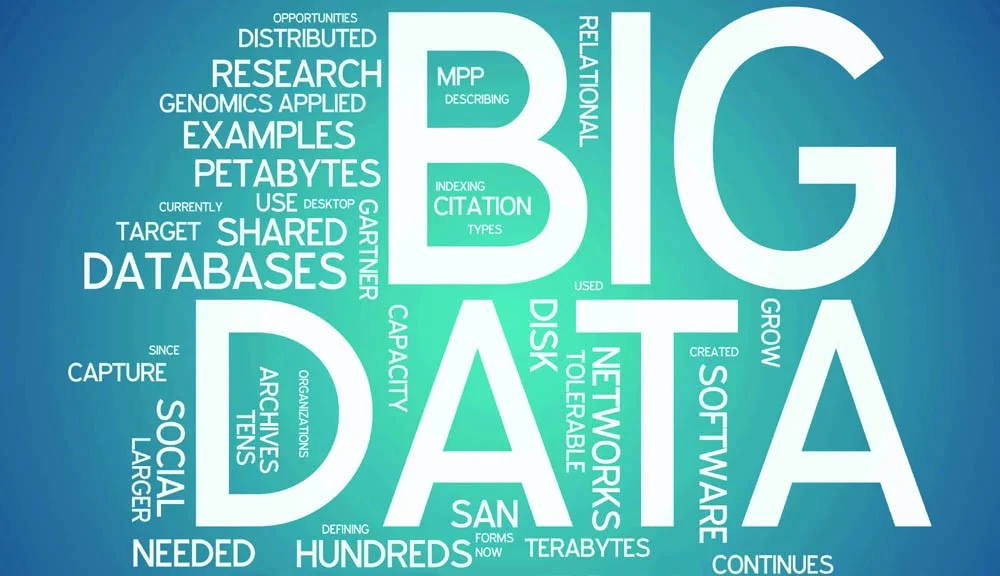Hello!
Data management via Big Data technology and tools is an important topic at both the state and enterprise levels. Today, 60% of the market is dominated by large companies that use Big Data technology. This tech is being used by more small and medium-sized businesses each year.
 Big Data management and analysis will not be the exclusive domain of large corporations by 2025. Big Data technology will continue its role in optimizing internal processes and enabling more effective work over the next few years.
Big Data management and analysis will not be the exclusive domain of large corporations by 2025. Big Data technology will continue its role in optimizing internal processes and enabling more effective work over the next few years.
What lessons can we learn from the people who have already implemented the technology into their workflows? Let’s first look at some bright Big Data success stories.
Big Data is a new business development driver
The volume of information generated in the era of digital technologies is increasing exponentially. A company can already analyze data if it has an app and a website. How can this help the business?
This question was first asked by large companies seven years ago. Only 17% of global companies used Big Data in 2015, however. Big Data has been adopted by banks, IT companies, and telecoms businesses.
 It’s not surprising. These industries accumulate the largest amount of data. Data is accumulated by banks through transactions. Telecoms acquire data via geodata. Search engines use query history to get data.
It’s not surprising. These industries accumulate the largest amount of data. Data is accumulated by banks through transactions. Telecoms acquire data via geodata. Search engines use query history to get data.
A wide variety of industries in the United States are using Big Data. However, this technology is much more in demand in Europe and Asia.
In the past five years, Big Data has been used by three times as many businesses as ever before. The application will continue to grow. Statista predicts the global Big Data market to reach $103 billion in 2027, more than double what it was in 2020.
Big Data Trends and Tendencies.
 Big Data technology is a risk for companies that don’t pay attention to it. This is why there is a growing interest in Big Data technology. Caterpillar, a major manufacturer of specialized equipment, revealed that its distributors suffered losses of $15 billion because they did not implement Big Data technologies.
Big Data technology is a risk for companies that don’t pay attention to it. This is why there is a growing interest in Big Data technology. Caterpillar, a major manufacturer of specialized equipment, revealed that its distributors suffered losses of $15 billion because they did not implement Big Data technologies.
Caterpillar boasts more than 3.5 million vehicles with sensors that gather data about operating conditions. These data help owners optimize their equipment and manage maintenance costs.
Losing customers and missed optimization are two common ways that lost profits can manifest. Businesses are now focusing on internal Big Data expertise. Therefore, it is essential to have a solid understanding of Big Data’s Effect on processes.
Investments in Big Data analytics are rising. Companies that have Big Data analytics in place will continue to grow the number of Big Data projects they undertake over the next few years.
 Depending on the industry, Big Data analytics spending will vary. Telecom companies spend millions on Big Data analytics. Telecom companies use increasing numbers of servers to store and process their data. It also helps to protect data confidentiality and privacy.
Depending on the industry, Big Data analytics spending will vary. Telecom companies spend millions on Big Data analytics. Telecom companies use increasing numbers of servers to store and process their data. It also helps to protect data confidentiality and privacy.
Business Big Data solutions differ depending on the type of data collected and the challenges faced. Let’s take a look at some examples.
1. Big Data in eCommerce
Before personalization, marketers used surveys and sales analysis for customer needs. This method is not comparable to real life.
 H&M experienced ten consecutive quarters with falling profits in 2018, which threatened the company’s survival. Big Data algorithms were used to stabilize H&M’s situation. This allowed for the removal of 40% of inventory without having to lower sales.
H&M experienced ten consecutive quarters with falling profits in 2018, which threatened the company’s survival. Big Data algorithms were used to stabilize H&M’s situation. This allowed for the removal of 40% of inventory without having to lower sales.
Retailers have access to a lot of data that can be used to communicate with customers and optimize internal processes. The Walmart network also uses Big Data technology to process 2.5 petabytes per hour.
Modern retail is moving away from CRM marketing to predictive analytics.
2. Big Data in Healthcare
The potential for medical data analysis is immense.
 It’s possible to use Big Data technology in healthcare to:
It’s possible to use Big Data technology in healthcare to:
- Lower treatment costs
- Prevent epidemics
- Early screening for disease prevention
- Enhance your quality of life
Incorporate modern treatment techniques into your daily practice.
Express Scripts is the largest independent pharmacy benefit manager and the largest US pharmacy. They process millions of prescriptions each year for both home-delivered pharmacies and retail pharmacies.
They have so much information on individual patients that they can inform medical personnel about drug side effects before the medication is even prescribed.
This will lead to significant improvements in the country’s health system:
 Before prescribing pain relief, health care providers will assess if the patient is at high risk for addiction. It is possible to modify the treatment plan or monitor drug intake in such cases.
Before prescribing pain relief, health care providers will assess if the patient is at high risk for addiction. It is possible to modify the treatment plan or monitor drug intake in such cases.
Analyzing prescriptions, physiology, or other medical information can help you identify a chronic illness or an illness that has yet to be properly diagnosed.
The best way to predict the likelihood of readmission in the next 90 days is to analyze the patient’s compliance with the doctor’s orders.
3. Big Data in Telecommunication
 Telecommunication companies offer solutions that are attractive to many users each day.
Telecommunication companies offer solutions that are attractive to many users each day.
This creates a large field of fraud. The most common types of fraud are illegal access, authorization, fake profiles, and cloning. Fraud can also have a direct effect on the user’s relationships. Telecom professionals are well-equipped with tools and systems to detect fraud.
China Mobile, the world’s largest mobile operator by subscribers, developed Sky Shield based on Big Data analysis and machine learning technology. It can detect fraudsters’ phrases and intercept spam mails and phone calls. The extensive fraud database provided by police departments was used to train the algorithm.
It can identify users who are most likely to spam and notify them. China Mobile claims that the accuracy of the Sky Shield improves as it is used.
4. Big Data Potential for Web Application Development
Big Data can be used by companies to improve their internal processes through its integration and incorporation into existing corporate mobile or web applications.
 UPS Logistics, which is the largest supply chain management company in America, delivers 16.9 million goods each day to more than 220 countries. Without Big Data solutions, it can’t function.
UPS Logistics, which is the largest supply chain management company in America, delivers 16.9 million goods each day to more than 220 countries. Without Big Data solutions, it can’t function.
The Orion application was implemented by the company to optimize routes and reduce costs. It stands for Onroad Integrated Optimization & Navigation.
This app is the fleet management website. To generate optimal routes, the system uses large cartographic data, including data on arrival and departure points, as well as data about sizes and delivery times.
UPS reduces fuel consumption by around 6 million liters per year, cuts carbon emissions by 13,000 tons/year, and speeds up delivery times.
5. Big Data Benefits for Education
 Skillsoft, an American leader in educational programs for corporate and professional employees, partnered with IBM to leverage internal data about user interactions.
Skillsoft, an American leader in educational programs for corporate and professional employees, partnered with IBM to leverage internal data about user interactions.
This allowed them to personalize their experience, increase engagement and improve learning outcomes directly through email newsletters and the program.
To monitor engagement and determine the most effective time and channels of communication to grab users’ attention, we used data about user activity.
A recommendation system for educational content was also created based on user preferences (84% of users rated it as relevant). The company also incorporated data-based visualization tools that can be tailored to each user of the system.
6. Marketing Advantages from Big Data
BikeBerry, an online store selling motorcycles and bicycles, has developed sophisticated machine learning algorithms as well as statistical models to track and predict customer shopping habits. BikeBerry was able to identify and use behavioral patterns thanks to the combination of data from purchase history, demographics, and behavioral information.
The store was able to recommend the best products to customers.
 They also began offering targeted discounts to customers who needed them:
They also began offering targeted discounts to customers who needed them:
- Increase sales by 133%;
- Improve user activity by 200%;
- Double the number of returning customers;
- Increase the average check of such customers by 30%.
7. Transport Big Data
 Union Pacific Railroad, the largest railroad corporation in America, used Big Data to improve its risk management system.
Union Pacific Railroad, the largest railroad corporation in America, used Big Data to improve its risk management system.
This resulted in a 75% decrease in train derailments.
The company gathered data from the temperature, acoustic, and visual sensors of each locomotive as well as information about weather conditions and the location of trains.
Union Pacific was able, using the data, to create predictive models that allowed for monitoring the condition of the railway and predicting train derailments days or weeks ahead of an incident.
Big Data technology has made it possible for such problems to be handled quickly, avoiding delays and damage to trains.
8. Big Data Trends in Public Administration
Big Data analysis is used by governments to make decisions in areas such as healthcare, emergency response, economic regulation, and crime and security.
The Los Angeles Police Department used a Big Data solution to determine the most likely terms, areas, and locations of different crime types. They then dispatch additional officers to stop them. The LAPD uses historical data to determine the type and location of crimes and then processes them using clustering algorithms within space and time.
This case does not contain any personal information about the residents of the city or their locations. This allows for compliance with privacy regulations. The decline in crime has also resulted in financial savings to the police, judiciary, and correctional system.
9. Impact of Big Data on Agriculture
 Data analysts believe Big Data offers the best prospects for conservative industries such as agriculture. Because big data can help to save labor and resources in this sector,
Data analysts believe Big Data offers the best prospects for conservative industries such as agriculture. Because big data can help to save labor and resources in this sector,
The global food demand is expected to almost double by 2050, which puts farmers under pressure to increase their output. Big Data is the data collected from soil sensors, tractors with GPS trackers, local meteorological channels, and tractors with GPS trackers.
Farmers can use this data to analyze and manage their seeds, fertilizers, pesticides, and other information. It also helps to increase productivity.
10. Big Data Benefits for the Mining Industry
 Companies in the mining industry face greater competition because of increased environmental requirements. Companies must use as few resources as possible to keep up with this trend.
Companies in the mining industry face greater competition because of increased environmental requirements. Companies must use as few resources as possible to keep up with this trend.
Severstal, a mining giant, has implemented a system that uses the Internet of Things to track electricity consumption. The company claims that the solution can improve energy consumption forecasts by 20-25% per month and help to save $10 million annually. It also reduces fines and optimizes procurement.
Conclusion
Big Data has been used by businesses for a long time. The flow of data is much more intensive than it has ever been. Today, social networks, applications, and online services can all be interlinked. Businesses can also get a complete picture of their potential customers.
Many people would consider Big Data “the new gold.” Data analysts predict Big Data will soon be the main decision-making tool of every company. This technology will be a huge benefit to both small and large international companies.
Thank you!
Join us on social networks!
See you!






